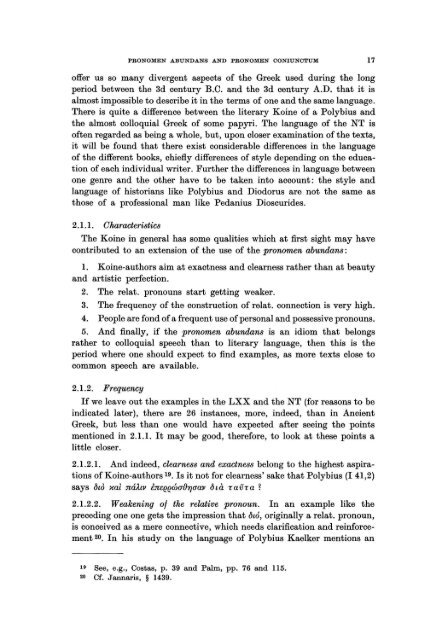Pronomen Abundans and Pronomen Coniunctum. A ... - DWC
Pronomen Abundans and Pronomen Coniunctum. A ... - DWC
Pronomen Abundans and Pronomen Coniunctum. A ... - DWC
You also want an ePaper? Increase the reach of your titles
YUMPU automatically turns print PDFs into web optimized ePapers that Google loves.
PRONOMEN ABUNDANS AND PRONOMEN CONIUNCTUM 17<br />
offer us so many divergent aspects of the Greek used during the long<br />
period between the 3d century B.C. <strong>and</strong> the 3d century A.D. that it is<br />
almost impossible to des cri be it in the terms of one <strong>and</strong> the same language.<br />
There is quite a difference between the literary Koine of a Polybius <strong>and</strong><br />
the almost colloquial Greek of some papyri. The language of the NT is<br />
of ten regarded as being a whoie, but, upon closer examination of the texts,<br />
it will be found that there exist considerable differences in the language<br />
of the different books, chiefly differences of style depending on the education<br />
of each individual writer. Further the differences in language between<br />
one genre <strong>and</strong> the other have to be taken into account: the style <strong>and</strong><br />
language of historians like Polybius <strong>and</strong> Diodorus are not the same as<br />
those of a professional man like Pedanius Dioscurides.<br />
2.1.1. Characteristics<br />
The Koine in general has some qualities which at first sight may have<br />
contributed to an extension of the use of the pronomen abundans :<br />
1. Koine-authors aim at exactness <strong>and</strong> clearness rather than at beauty<br />
<strong>and</strong> artistic perfection.<br />
2. The relat. pronouns start getting weaker.<br />
3. The frequency of the construction of relat. connection is very high.<br />
4. People are fond of a frequent use of personal <strong>and</strong> possessive pronouns.<br />
5. And finally, if the pronomen abundans is an idiom that belongs<br />
rather to COllOquial speech than to literary language, then this is the<br />
period where one should expect to find examples, as more texts close to<br />
common speech are available.<br />
2.1.2. Frequency<br />
If we leave out the examples in the LXX <strong>and</strong> the NT (for reasons to be<br />
indicated later), there are 26 instances, more, indeed, than in Ancient<br />
Greek, but less than one would have expected af ter seeing the points<br />
mentioned in 2.1.1. It may be good, therefore, to look at these points a<br />
little closer.<br />
2.1.2.1. And indeed, clearness <strong>and</strong> exactness belong to the highest aspirations<br />
of Koine-authors 19. Is it not for clearness' sake th at Polybius (I 41 ,2)<br />
says bLO xal náÀw lneeewa{}'YJaav bLà -rav-ra 1<br />
2.1.2.2. Weakening ot the relative pronoun. In an example like the<br />
preceding one one gets the impression that bLÓ, originally arelat. pronoun,<br />
is conceived as a mere connective, which needs clarification <strong>and</strong> reinforcement<br />
20. In his study on the language of Polybius Kaelker mentions an<br />
19 See, e.g., Costas, p. 39 <strong>and</strong> Palm, pp. 76 <strong>and</strong> 115.<br />
20 Cf. Jallnaris, § 1439.
















